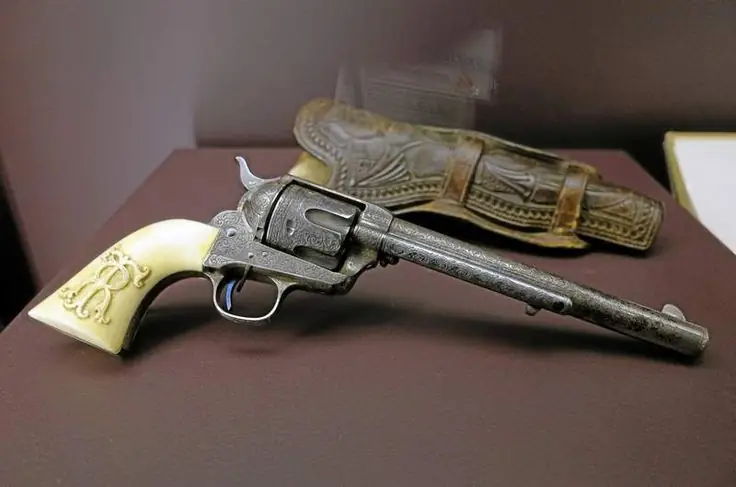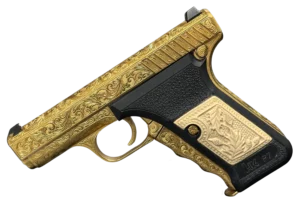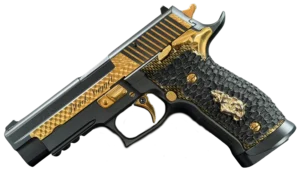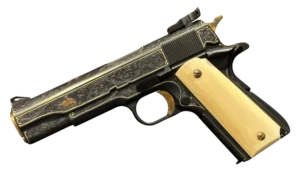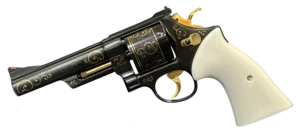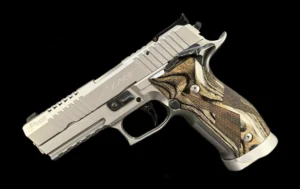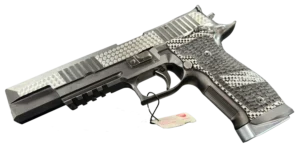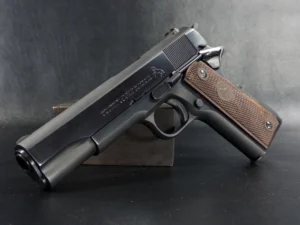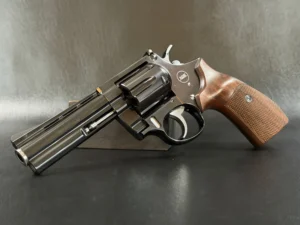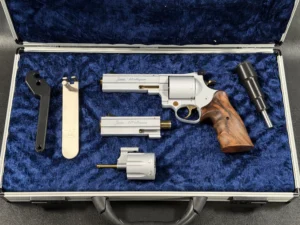Key Takeaways:
- These revolvers aren’t just guns, they’re personal stories cast in steel: Every high-dollar revolver comes with baggage, in the best way. Whether it was carried by a president or hand-engraved by a forgotten master, these pieces tell you more than specs ever could. They speak to history, identity, and the weird human urge to make even deadly tools beautiful.
- Craftsmanship and provenance matter more than firepower: Let’s be real: no one’s paying seven figures for rate of fire. What drives the price is detail, the scrollwork, the rare serial numbers, and the letters that prove it once sat on Ulysses S. Grant’s desk. The market chases soul, not just steel.
- The collector’s market isn’t dying, it’s evolving: Old revolvers are finding new fans. Younger collectors are emerging, valuing authenticity in a world dominated by plastic. And while the old legends still reign, modern masterpieces from brands like Korth and Janz are already shaping the next generation of “most expensive” revolvers. The game isn’t over, it’s just getting more interesting.
Let’s get something out of the way first: these aren’t just guns. Not really. The revolvers we’re about to talk about? They’re time machines. Art pieces. Symbols. Sometimes, all three at once. They weren’t just built to fire rounds — they were built to last and, oddly enough, to speak. Every scratch, every engraving, every odd little design choice whispers something about the era it came from, the person who held it, or the legend it eventually became.
So, yeah, when we talk about the world’s most expensive revolvers, we’re not just talking about price tags. We’re talking about legacy — and the kind of craftsmanship that makes even people who don’t know a cylinder from a barrel stop and stare.
Let’s dive in.
When Revolvers Went from Grit to Glamour
Once upon a time — not that long ago, really — revolvers were tools. Meant to be used and carried on dusty trails, under trench coats, or in a drawer beside the bed. They had one job: work when you needed them to.
However, as the decades passed, something changed.
Somewhere between the smoke and steel of the mid-1800s and the precision machining of today, revolvers started picking up polish. Literally and metaphorically. Engravers began turning blank frames into intricate canvases. Gunmakers flirted with luxury — rare metals, custom grips, gold inlays. Suddenly, these weapons weren’t just for protection. They were status symbols. Family heirlooms. Museum pieces.
It’s funny how that happens. One day you’re making a tool, the next it’s a work of art.
So, What Makes a Revolver Ridiculously Expensive?
Spoiler: It’s not just the caliber.
There are a few things that really push a revolver into “sell-your-house-for-it” territory, and none of them are about ballistics. It’s about stories. It’s about who owned it, who made it, and how it looks now.
Here’s the short list of what sends prices sky-high:
- Craftsmanship. The kind that takes hundreds of hours and maybe a magnifying glass to fully appreciate.
- Historical significance. If someone famous shot it — or even just owned it — expect a bidding war.
- Provenance. A fancy word for “a well-documented history of ownership.” Paperwork matters, weirdly enough.
- Materials. Gold, silver, ivory, mother of pearl — nothing says “expensive” like building a gun out of treasure.
- Limited production. One-of-a-kind or ultra-limited runs are collector kryptonite.
And let’s not forget branding. A Colt or Smith & Wesson with a rare serial number and factory engraving? That’s like finding a signed first-edition Hemingway. But heavier. And louder.
Engraving: The Art That Hides in Plain Sight
Have you ever stared at a revolver so long you forgot it’s a weapon?
That’s the kind of experience you get with premium engraving. It’s one thing to etch your initials onto a grip; it’s another to turn the whole thing into a scroll-filled, gold-inlaid tapestry. Some of these designs are so detailed that they practically require a jeweler’s loupe. Seriously — we’re talking about artwork on a curved metal surface the size of a playing card.
Master engravers like Gustave Young (we’ll come back to him) helped pioneer this art form. Their work elevated firearms into the kind of pieces you don’t just use — you pass down. Or lock it away in a velvet-lined case. Or display in a museum.
And the best part? Each engraver has a signature style, like a fingerprint. That alone can add thousands to the price — if not more.
When Guns Tell Stories: Provenance & Famous Fingers
Here’s where things get spicy.
Owning a gorgeous revolver is one thing. Owning a revolver that used to belong to Ulysses S. Grant or Theodore Roosevelt? Now you’re talking about history you can hold in your hand.
Collectors go absolutely nuts for guns with a story — especially if it’s documented. That’s where provenance comes in. A signed letter, a photo, a factory letter — these can turn a nice piece into a historical artifact. Add a famous name and the price skyrockets.
Sometimes, it’s a battlefield story. Sometimes, it’s tied to politics, pop culture, or even a Hollywood legend. Either way, when a revolver has a backstory, it becomes more than metal. It becomes a myth.
Let’s Talk Numbers: The Revolvers That Broke the Bank
Okay, now we’re getting to the good stuff. The revolvers made headlines, cleared bank accounts, and found homes in the vaults of private collectors (or, occasionally, a museum lucky enough to get a donation).
Here are some of the most outrageously expensive revolvers ever sold — and the legends that made them worth every penny.
Ulysses S. Grant’s Cased Remington New Model Army Revolvers
Grant didn’t just win the Civil War — he also had excellent taste.
This matched pair of Remingtons, presented to the man himself, came in an engraved, velvet-lined case. They’re stunning. Silver-plated, beautifully engraved, and historically irreplaceable. The craftsmanship alone is impressive, but pair that with a name like Grant? That’s the jackpot.
They sold for a whopping $5.17 million.
And let’s be real — you’re not buying these because they shoot straight. You’re buying them because they once sat in the hands of a man who changed the course of a nation.
The Danish Sea Captain’s Colt Walker
This one’s kind of a mystery. Which makes it all the more interesting.
A Colt Walker — already rare as hen’s teeth — somehow ended up in the hands of a Danish sea captain in the mid-1800s. The details? A little fuzzy. The appeal? Off the charts.
It’s an early production model, which helps. It’s also in incredible shape, which is rare for a revolver made to be dragged across Texas on horseback. Throw in the backstory and the mystique, and you’ve got a revolver that sold for north of $1.8 million.
For a gun designed to survive brutal combat, it aged like fine wine.
Theodore Roosevelt’s Factory-Engraved Colt Single Action Army
Now, this one almost feels obvious.
Theodore Roosevelt was a cowboy president — a rancher, Rough Rider, and all-around American legend. So, of course, he had a revolver that was just as bold as he was.
His Colt Single Action Army is a stunner: factory engraved, custom ordered, and likely carried during his post-presidency adventures. The engraving alone is museum-worthy. Roosevelt’s name? That’s the cherry on top.
This revolver didn’t just look good — it had swagger.
The G. Young-Engraved Colt Millikin Dragoon
If you’re into deep cuts, this one’s for you.
Gustave Young, the master engraver mentioned earlier, left his mark on this 2nd Model Dragoon built for Colonel John Millikin. The gun is a visual feast — floral scrolls, patriotic motifs, intricate detailing. It’s basically the 19th-century version of bespoke art.
Collectors love Young’s work because it bridges the gap between function and flourish. This Dragoon? It’s a museum on a trigger.
Sold for seven figures — and worth every dime.
Modern Luxury Revolvers: Old Soul, New Tech
Not every expensive revolver comes from a dusty battlefield or a Wild West saloon. Some of the priciest pieces out there are modern — precision-machined marvels with tolerances tighter than your grandmother’s Tupperware lids.
Take brands like Korth, Janz, or even high-end Smith & Wesson Performance Center models. These things are built like watches — Swiss-level engineering packed into a revolver. You’re looking at titanium frames, DLC coatings, exotic hardwood grips, and tolerances measured in microns.
They don’t just look cool. They shoot like dreams.
And here’s the thing — because they’re made in such small numbers, they’re already collectible. Twenty years from now? Who knows how many of these modern marvels will be six-figure legends?
Thinking About Collecting? A Few Tips (from People Who’ve Been Burned)
Let’s say this article has you intrigued. Maybe you’re thinking about dipping your toes into revolver collecting. Great! Just… go in with your eyes open.
Here’s what seasoned collectors wish someone had told them:
- Do your homework. History matters — and fakes are a thing. Read. A lot.
- Provenance is everything. If a seller can’t prove it, be skeptical.
- Condition isn’t everything — but it helps. Some wear is cool. Rusted junk? Not so much.
- Network. Gun shows, online forums, and even auction previews. Meet people. Ask questions.
- Buy what you love. That sounds cliché, but seriously — don’t just chase the hot item. Get the one that speaks to you.
Oh — and don’t forget safe storage. You’re buying legacy, not liability.
Where’s This All Going?
You’d think interest in revolvers would’ve dropped off by now, especially with all the polymer, red-dot-equipped stuff dominating the modern market.
But no. If anything, collecting is hotter than ever.
Why? Because people are starting to realize you can’t 3D print soul. You can’t fake hand-engraving. And no matter how fancy modern guns get, they’ll never have the lived-in gravitas of a revolver that’s survived wars, wild frontiers, or even just time.
There’s a growing appreciation for the tactile, the old-school, the real. And revolvers — especially the rare, expensive ones — offer all that in spades.
Final Shot: Why These Revolvers Still Matter
So, why do these relics still hold such power?
Maybe it’s because they’re so stubbornly analogous in a digital world. Perhaps it’s the way they connect us to the past — to moments of bravery, chaos, or transformation. Or maybe, weirdly enough, it’s because they’re beautiful.
Not beautiful in a fragile, delicate way. Beautiful in a rugged, scarred, you-wouldn’t-believe-the-things-I’ve-seen kind of way.
And yeah, they’re expensive. Some of them wildly so. But when you hold one — really study it, feel the weight, the balance, the etched steel — it makes a particular kind of sense.
These aren’t just revolvers.
They’re stories you can hold.
Frequently Asked Questions
It’s not because they shoot gold bullets or anything. The price comes down to a mix of craftsmanship, historical significance, and who owned it. A revolver that’s beautifully engraved, in pristine condition, and that once belonged to someone like Theodore Roosevelt? Yeah, that’s going to set off fireworks at auction.
Weirdly, yes — but once you’ve seen a masterwork up close, it’s not weird at all. Engraving turns a functional object into something you want to stare at for hours. And if it was done by a legendary hand, like Gustave Young? That alone can add tens or even hundreds of thousands to the price tag.
Think of provenance as a paper trail with personality. It’s the story of where the gun’s been and who it belonged to. If a revolver comes with documents showing it was gifted to a Civil War general or passed down through a famous family, boom, it just became 10 times more interesting (and valuable).
Both have their place. Antique revolvers come with built-in history, but modern luxury models, such as Korth, Janz, or high-end Smith & Wesson, are technical masterpieces. Plus, some of them are made in such small batches that they’re already future collectibles.
Great question. And honestly? It’s easy to get burned if you don’t do your homework. Always request documentation, including factory letters, auction history, and expert appraisals. Talk to trusted collectors. And if something feels off or too good to be true? Trust your gut.


